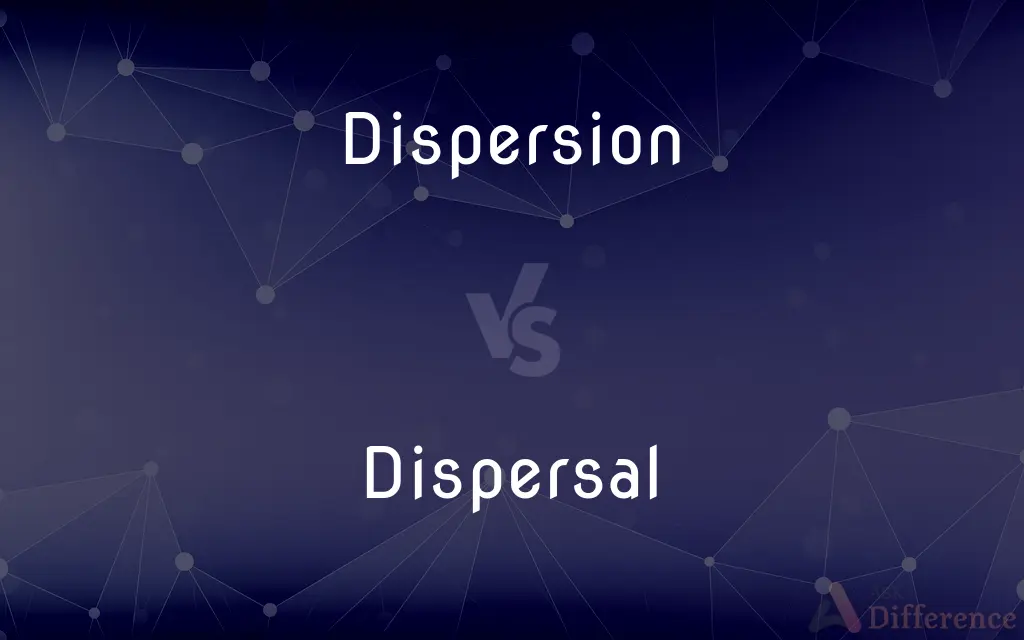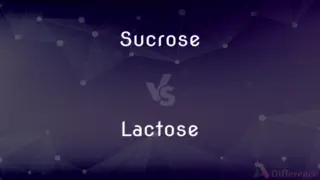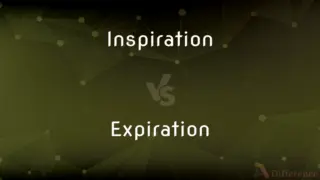Dispersion vs. Dispersal — What's the Difference?
By Maham Liaqat & Fiza Rafique — Updated on March 16, 2024
Dispersion is the spread of entities over an area or volume, focusing on distribution patterns, while dispersal refers to the movement or spreading of organisms from their origin to other locations.

Difference Between Dispersion and Dispersal
Table of Contents
ADVERTISEMENT
Key Differences
Dispersion describes how individuals in a population are spaced out across an area or volume. It's a term often used in ecology to discuss the spatial arrangement of organisms within a habitat, which can be uniform, random, or clumped. Dispersal, on the other hand, is the process by which organisms move or are carried away from their birthplace or current location to new areas. This movement is crucial for the colonization of new habitats, the reduction of inbreeding, and the spreading of species.
In the context of light or sound, dispersion refers to the way these waves spread out or scatter as they travel through different mediums, often resulting in phenomena like rainbows or echoes. Dispersal in a similar physical context could involve the distribution of particles or energy from a central point, but it's less commonly used in this sense compared to biological dispersal.
Ecologically, dispersion patterns can greatly influence the dynamics of a population, affecting mating, competition, and resource allocation. Dispersal mechanisms, such as wind, water, or animal carriers, play a significant role in ecosystem biodiversity by enabling gene flow and species diversity across different regions.
Human activities can affect both dispersion and dispersal. For example, urban development can alter the natural dispersion patterns of species by fragmenting habitats. Similarly, human actions can facilitate or hinder the dispersal of species, intentionally or unintentionally, through activities like trade, travel, and landscaping.
Understanding the differences between dispersion and dispersal is essential for conservation efforts, habitat management, and predicting the impacts of environmental changes on species distribution and ecosystem health.
ADVERTISEMENT
Comparison Chart
Definition
Spread of entities across an area or volume
Movement of organisms from their origin
Context
Often ecological, describing population distribution patterns
Primarily biological, focusing on organism movement
Examples
Uniform, random, clumped arrangements in a habitat
Seed dispersal by wind, animal migration
Impact
Influences population dynamics and resource allocation
Affects colonization, gene flow, species diversity
Influenced by
Environmental factors, species interactions
Mechanisms like wind, water, animal carriers
Compare with Definitions
Dispersion
Describes how individuals are spaced in an area.
The uniform dispersion of plants in an agricultural field ensures equal access to resources.
Dispersal
Organisms move from their birthplace to new areas.
Birds dispersing seeds over wide areas contribute to plant diversity.
Dispersion
Affects mating, competition, and survival.
Clumped dispersion in fish schools helps in protecting members from predators.
Dispersal
Essential for accessing new habitats and reducing inbreeding.
Animal dispersal can lead to the colonization of isolated islands.
Dispersion
Environmental factors shape dispersion patterns.
Random dispersion of trees in a forest can result from varied seed dispersal methods.
Dispersal
Involves various vectors like wind, water, or animals.
Dandelion seeds are dispersed by wind, enabling widespread colonization.
Dispersion
Quantified using statistical methods to understand population structure.
Ecologists use dispersion indices to study bird nesting patterns.
Dispersal
Can be affected by human activities such as landscaping or transport.
Invasive species are often dispersed through global trade.
Dispersion
Critical for understanding ecosystem structure.
The dispersion of predator populations can influence prey distribution.
Dispersal
Understanding dispersal is key for habitat restoration and species protection.
Conservationists consider animal dispersal routes when designing wildlife corridors.
Dispersion
The action or process of distributing things or people over a wide area
Some seeds rely on birds for dispersion
Dispersal
The act or process of dispersing or the condition of being dispersed.
Dispersion
The separation of white light into colours or of any radiation according to wavelength.
Dispersal
The act or result of dispersing or scattering; dispersion.
Dispersion
The extent to which values of a variable differ from a fixed value such as the mean.
Dispersal
A dispersal prison.
Dispersion
The act or process of dispersing.
Dispersal
The act or result of dispersing or scattering; dispersion.
Dispersion
The state of being dispersed.
Dispersal
The act of dispersing or diffusing something;
The dispersion of the troops
The diffusion of knowledge
Dispersion
Dispersion The Diaspora of the Jews.
Dispersion
(Statistics) The degree of scatter of data, usually about an average value, such as the median.
Dispersion
Separation of a complex wave into its component parts according to a given characteristic, such as frequency or wavelength.
Dispersion
Separation of visible light into colors by refraction or diffraction.
Dispersion
(Chemistry) See disperse system.
Dispersion
The state of being dispersed; dispersedness.
Dispersion
A process of dispersing.
Dispersion
The degree of scatter of data.
Dispersion
(optics) The separation of visible light by refraction or diffraction.
Dispersion
(medicine) The removal of inflammation.
Dispersion
The act or process of scattering or dispersing, or the state of being scattered or separated; as, the Jews in their dispersion retained their rites and ceremonies; a great dispersion of the human family took place at the building of Babel.
The days of your slaughter and of your dispersions are accomplished.
Dispersion
The separation of light into its different colored rays, arising from their different refrangibilities.
Dispersion
Spreading widely or driving off
Dispersion
The spatial property of being scattered about over an area or volume
Dispersion
The act of dispersing or diffusing something;
The dispersion of the troops
The diffusion of knowledge
Common Curiosities
Why is understanding dispersion important in ecology?
Understanding dispersion helps in assessing population dynamics, resource distribution, and the overall health of ecosystems.
Is human-induced dispersal always negative?
Not always; while it can lead to invasive species issues, it can also be beneficial for re-establishing species in habitats from which they have been eradicated.
How do dispersion patterns affect conservation strategies?
Conservation strategies often rely on understanding dispersion to create effective protected areas, manage populations, and ensure genetic diversity.
Can technology be used to track dispersal?
Yes, technologies like GPS tracking, satellite imaging, and RFID tags are used to monitor the movements and dispersal patterns of wildlife.
Can dispersal lead to invasive species problems?
Yes, when organisms are dispersed to new areas where they have no natural predators, they can become invasive and disrupt local ecosystems.
How do dispersal strategies differ among species?
Dispersal strategies can vary widely among species, from passive wind or water dispersal in plants to active migration in animals.
What role do animals play in plant dispersal?
Animals can be crucial for plant dispersal, carrying seeds through consumption and movement, thus aiding in plant reproduction and diversity.
Are there mathematical models to predict dispersion and dispersal?
Yes, various mathematical and computational models are used to predict and analyze dispersion and dispersal patterns in ecological studies.
How does dispersal contribute to biodiversity?
Dispersal mechanisms facilitate the spread of species to new habitats, contributing to ecosystem complexity and biodiversity.
How does climate change affect dispersal?
Climate change can alter dispersal patterns by shifting habitats and changing the behaviors and distributions of dispersal agents like wind and water currents.
What is the role of dispersal in island biogeography?
Dispersal is a key factor in island biogeography, influencing species richness and community composition on islands.
How does human development impact dispersion and dispersal?
Human development can fragment habitats, create barriers to dispersal, and alter natural dispersion patterns, affecting wildlife and ecosystem health.
How do barriers affect dispersal and dispersion?
Barriers like roads, urban development, and rivers can limit dispersal and alter dispersion patterns, potentially leading to fragmented populations.
Can dispersion patterns change over time?
Yes, dispersion patterns can change due to environmental pressures, species interactions, and habitat alterations.
Can artificial dispersal be used for ecosystem restoration?
Artificial dispersal, such as reseeding or reintroducing species, is a tool in ecosystem restoration efforts to enhance habitat recovery.
Share Your Discovery

Previous Comparison
Sucrose vs. Lactose
Next Comparison
Inspiration vs. ExpirationAuthor Spotlight
Written by
Maham LiaqatCo-written by
Fiza RafiqueFiza Rafique is a skilled content writer at AskDifference.com, where she meticulously refines and enhances written pieces. Drawing from her vast editorial expertise, Fiza ensures clarity, accuracy, and precision in every article. Passionate about language, she continually seeks to elevate the quality of content for readers worldwide.













































